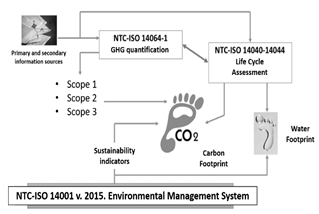1. Introduction
Sustainability reports and determining environmental impacts have become important tools for many decision-makers and policy designers because they provide comprehensive information and enable organizational changes to increase competitiveness, while reducing costs and negative environmental impacts, for example, through the rational and efficient consumption of energy (ISO 50001) and/or manufacturing products and providing services that are carbon neutral (ISO 14064) [1-5].
The operation and maintenance of a university is a socioeconomic process that transforms raw materials, energy, and water into wastes, while it conducts its activities. Every part interacts and interchanges materials, energy, and information with its surroundings through a complex network [6]. These flows should be monitored and analyzed from the point of view of sustainability and adopting a quantitative methodology that considers their negative impact and environmental damage to plan mitigation measures that can be implemented and identify potential emission reductions [5,7,8].
The aim of this study is to determine and analyze the Carbon Footprint of one campus of the Instituto Tecnológico Metropolitano (Medellín, Colombia), which has implemented and applied the NTC-ISO 14001:2015 standard. This kind of study can enable ITM students and community to understand carbon footprint and their responsibility to reduce it, thus fostering cultural change inside the organization [7,9].
The Instituto Tecnológico Metropolitano is committed to being carbon neutral, a beacon for society, and a sustainable educational institution. Therefore, in this study, the Carbon Footprint of the ITM was determined using Life Cycle Assesment (LCA). Fig. 1 shows a graphical representation of the LCA, including its boundaries, scope, and balance of input and output flows.
The objective of using Life Cycle Assessment is to provide greater benefits in the short and long term by employing the knowledge and understanding of the consecutive and interrelated stages of the organization’s product and/or service system, from the acquisition or production of raw materials from natural resources to their treatment at the end of their useful life [10-12]. In addition, LCA can produce financial savings and utility cost reductions and establishes a baseline for source-specific evaluation and future mitigation efforts [13,14].
2. NTC-ISO 14064 report structure
2.1 Description of the object of study 1
The ITM is a university institution with a technological orientation, vocation, and tradition. It is a public municipal institution with five campuses in Medellín: Robledo, Fraternidad, Floresta, Castilla, and Prado. This study analyzes Robledo campus in 2016, when it had an average of 9,865enrolled students and ITM’s building of administrative offices is located on this campus.
Currently, the ITM’s physical infrastructure continues to grow, its teaching staff and administrative staff are better qualified, its academic programs are more innovative, and it is widely recognized as it was the first public university in Colombia to be accredited as a High-Quality institution.
Additionally, the ITM is committed to the continuous improvement of its environmental management system. As a result, it is taking actions, in the medium term, to reduce its Carbon Footprint and become a carbon neutral organization through programs aimed at the rational and responsible use of natural resources and the correct handling and final disposal of chemical substances; in addition, all ITM students receive environmental education courses. The ITM’s Environmental Management System focuses on six environmental programs: water discharge management, efficient use of water and water saving, efficient use of energy and energy saving, comprehensive management of solid waste, adequate storage of chemical substances, and environmental education. All these programs are mentioned here because they contribute to have a green campus [15].
2.2 Functional unit
Considering the mission, vision, and operating aims of the ITM, in this study, the Functional Unit is one (1) student currently enrolled in one of its study programs. However, the Total Carbon Footprint is reported by scope and resource so that this sustainability indicator can be compared with that of other institutions that provide academic services, as reported in the literature [14,16].
2.3 Operational limit
To calculate the Carbon Footprint (CF) of ITM’s Robledo campus, direct and indirect emissions were first quantified and represented within the operational limits and scopes of the study. Such scopes are shown in Fig. 2 and described below.
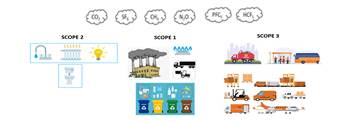
Source: The authors.
Figure 2 Graphical representation of the scopes in the GHG emissions calculation methodology.
• Scope 1. Direct GHG emissions: Paper consumption; fuel for transportation and machinery operation; administrative, operational, and teaching staff; refrigeration equipment; air conditioning; and fire extinguishers.
Therefore, given the specific characteristics of the operation, Scope 1 also includes emissions associated with GHG mitigation activities, such as composting organic and biodegradable waste and solid waste recycling thanks to the fact that the ITM stablished a direct control through a sound internal waste management policy.
• Scope 2. Indirect GHG emissions: Electricity and water consumption.
• Scope 3. Other indirect emissions: This scope will not be considered in its entirety in this study because this is the first time that the CF of the ITM is determined. However, this paper does consider its carbon footprint impact due to waste transport from the ITM to the landfill. This service is provided by a municipal sanitation company.
Organizations can exclude direct or indirect GHG sources whose contribution to gas emissions or removals is not significant and those whose quantification would not be technically feasible according to the organizational context (in technical, economic, and temporal terms). However, these exclusions should be justified with precise arguments of why such sources were not included in the GHG inventory despite having operational or financial control over the facilities [17].
3. Calculation of Carbon Footprint (CFP) and emission factors
Table 1 shows the description and unit used here to represent the impact category called Climate Change or Global Warming, according to reference [18].
Before calculating ITM’s Carbon Footprint, all the anthropogenic GHG emissions from inside the organization must be estimated (CO2, CH4, N2O, HFC, PFC, and SF6). Subsequently, this information was converted into equivalent CO2 emissions (kg CO2-eq) with the Global Warming Potential (GWP) [19,20]. Table 2 shows the conversion factors of different GHGs to equivalent kg of CO2 according to the references [21,22].
Table 2 Conversion factors of different GHGs to equivalent kg of CO2.
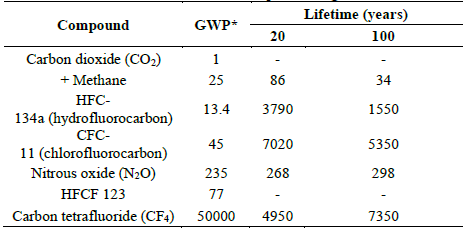
* Global Warming Potential (GWP) Source: The authors.
Regarding the emission factors of each type of resource, preference should be given to sources, applying standardized and globally supported methodologies. For example, an ideal study should be compatible with ISO 14040/44, the international standard for environmental life cycle assessment [23]. However, factors that depend on geographical location or the characteristics of the location of the object of study may be modified to perform a preliminary calculation [24,25].
Table 3 shows the GHG emission factors of the electricity and natural resources used by the ITM in its operation.
Table 3 GHG emission factors for greenhouse gas inventory
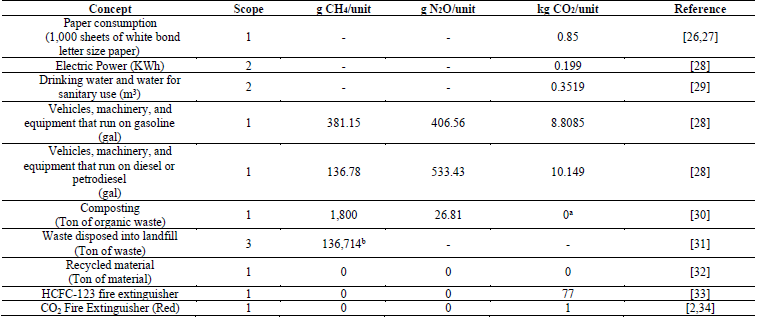
a Composting operations are considered carbon neutral (kgCO2/Ton=0) [21].
b Landfill without methane recovery (CH4).
c First-Life post-consumer waste has no environmental burden when it is recycled and used as raw materials in its Second Life [32].
Source: The authors.
Another element that generates CO2 emissions and is not generally considered is human labor, that is, the consumption of the energy needed to carry out different activities in organizations, human metabolism, and breathing. The equations for calculating this energy are illustrated in [35,36], and [37]. With the help of the information provided by the emission factors, type of resource, and the characteristics of each activity causing the emission, Eq. (1) was used to calculate the Carbon Footprint.
Where CFP is the Carbon Footprint of the organization, derived from the process of consumption of goods and/or services (kg of CO2-eq); ADi, the data on source activity i (based on a unit of measurement); and EFi, the emission factor of source i (kg CO2-eq/unit of measure).
4. Results
Table 4 shows the Total Carbon Footprint (Ton CO2-eq/year) of each scope and the contribution of each item to this sustainability indicator.
Thanks to the calculation of the Carbon Footprint by type of resource and scope, one can establish which activities have the greatest impact on the CF of an institution. For example, in the case of ITM Robledo campus, the activities that emit the most GHG fall within Scope 1, especially the use of fossil fuels (for the transportation of equipment and ITM employees), with about 69%; and, in Scope 2, electricity consumption contributes 26.8%.
Although it is difficult to compare the carbon footprint of different institutions, Table 5 shows the calculated Total Carbon Footprint (Ton CO2-eq/year) and the specific Carbon Footprint per student at several universities and higher education institutions in the United States and Latin America.
Table 5 Carbon Footprint (Ton CO2/year) of the ITM and higher education institutions around the world.
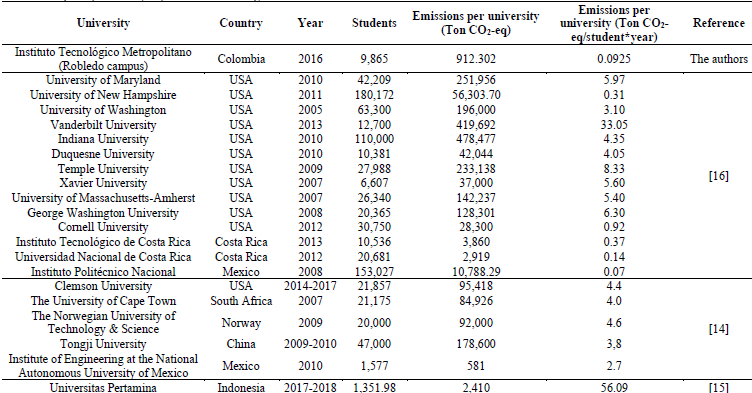
Source: The authors.
Another way to compare the total CF of institutions is using the CO2-eq emission weight of each scope. This methodology can be employed to identify the components that need an intervention to decrease the GHG emissions, inspired by the measures applied by other institutions with the lowest emissions.
For this purpose, this study considered the electricity, transportation, and waste data of several academical institutions as found in [15]. In addition, it includes the following ITM data:
Electricity: Electricity consumption (Scope 2).
Transportation: Fossil fuels (Scope 1).
Waste: Composting and mitigation due to waste separation and final treatment (Scope 1), transport of ordinary waste to landfill, and mitigation of transportation of organic and recyclable material (Scope 3).Table 6 compares the emission weights of electricity, transportation, and waste of several universities, including ITM Robledo campus.
Clearly, the total CF of each scope and resource of ITM Robledo campus is far below that of its contemporaries in the US, Europe, Africa, Asia, and Latin America. Therefore, the environmental program implemented by the ITM under ISO 14001:2015 is a good way to achieve GHG mitigation and become a carbon neutral institution. Furthermore, the ITM’s waste management program could be disseminated because it showed a negative carbon footprint.
The CF of the other campuses of the ITM should be calculated as well. However, the total CF of the whole institution should not increase in proportion because the environmental management system is implemented and certified in its campuses.
5. Conclusions
This article details a procedure to calculate the Carbon Footprint of Robledo campus of the Instituto Tecnológico Metropolitano (Medellín, Colombia). This sustainability indicator was estimated in accordance with the methodology described in ISO 14064 (Greenhouse Gas Measurement) and ISO 14040-14044 (Life Cycle Analysis) standards; information provided by the ITM; secondary information taken from scientific articles published in indexed journals and reports; and data and statistics published by government and other decentralized agencies related to environmental protection and the use of a country’s energy resources, such as the Environmental Protection Agency (EPA) in the US, the Mining and Energy Planning Unit (UPME) in Colombia, and the National Department of Statistics (DANE) in Colombia, among others.
One of the most important contributions of this study is the calculation of the Carbon Footprint associated with human activity or work, which consists of an analysis of direct CO2 emissions attributed to energy expenditure and the characteristics of human metabolism.
Therefore, ITM’s efforts to control and mitigate GHG emissions should focus on how to reduce consumption and a more rational use of fuel and electricity through changes in organizational culture, the use of renewable energy, and technological upgrading. However, these measures may require high investments. Thus, Thus, the ITM should implement mitigation measures that have been successful at other organizations, such as recovering materials through recycling and composting organic waste, as well as institutional campaigns to raise the environmental awareness of the academic community at ITM Robledo campus. These strategies are ideal as they are inexpensive to implement in the short term and help to mitigate the GHG emissions associated with Scope 3 (e.g., reducing emissions in the transportation of solid waste to the landfill).
This study can be used as a baseline for GHG tracking, monitoring, control, and mitigation activities, as well as the continuous improvement of GHG emissions at ITM Robledo campus, because it defines the amount of GHG the latter emits into the atmosphere classified by scope, resource, and/or activity. In addition, the methodology established in this paper can be extrapolated to all ITM campuses and even serve as a reference to estimate the Carbon Footprint of any type of organization because it observes international standards such as ISO 14040-14044 and ISO 14064.















